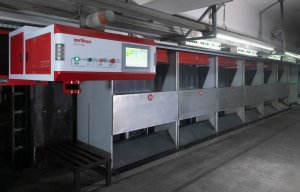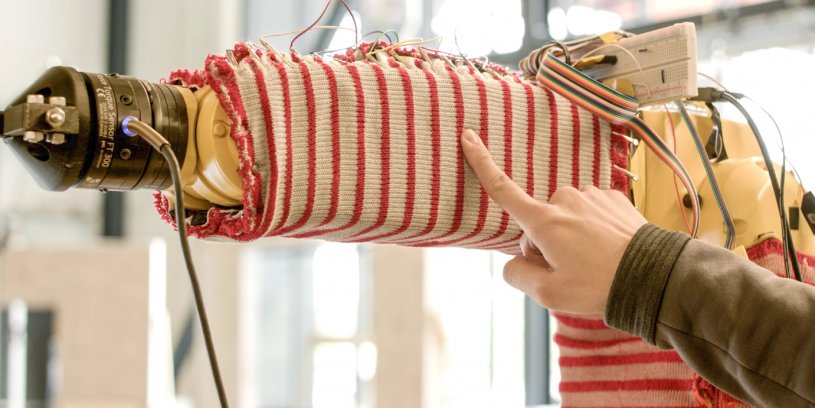
Wiping robots increase production efficiency in spinning
RobotSweater fabric can be customised to fit uneven three-dimensional surfaces.

2nd June 2023
Innovation in Textiles
|
Pittsburgh, PA, USA
The same qualities that make a knitted sweater comfortable and easy to wear will allow robots to better interact with humans.
The RobotSweater, developed by a research team from Carnegie Mellon University’s Robotics Institute, is a machine-knitted textile “skin” that can sense contact and pressure.
“We can use it to make the robot smarter during its interaction with humans,” says Changliu Liu, an assistant professor of robotics at the university’s School of Computer Science (SCS).
Just as knitters can take any kind of yarn and turn it into a sock, hat or sweater of any size or shape, the knitted RobotSweater fabric can be customised to fit uneven three-dimensional surfaces.
“Knitting machines can pattern yarn into shapes that are non-flat, that can be curved or lumpy,” says James McCann, an SCS assistant professor whose research has focused on textile fabrication in recent years. “That made us think maybe we could make sensors that fit over curved or lumpy robots.”
Once knitted, the fabric can be used to help the robot “feel” when a human touches it, particularly in industrial settings where safety is paramount. Current solutions for detecting human-robot interaction in industry look like shields and use very rigid materials that McCann notes can’t cover the robot’s entire body because some parts need to deform.
“With RobotSweater, the robot’s whole body can be covered, so it can detect any possible collisions,” says Liu.
The knitted fabric consists of two layers of yarn made with metallic fibres to conduct electricity. Sandwiched between the two is a netlike, lace-patterned layer. When pressure is applied to the fabric from someone touching it, the conductive yarn closes a circuit and is read by the sensors.
“The force pushes together the rows and columns to close the connection,” says Wenzhen Yuan, an SCS assistant professor and director of the RoboTouch lab. “If there’s a force through the conductive stripes, the layers contact each other through the holes.”
In addition to the design of the knitted layers – the culmination of hundreds of samples and tests – the team faced another challenge in connecting the wiring and electronics components to the soft textile.
“There was a lot of fiddly physical prototyping and adjustment,” McCann says. “The students working on this managed to go from something that seemed promising to something that actually worked.”
What worked was wrapping the wires around snaps attached to the ends of each stripe in the knitted fabric. Snaps are a cost-effective and efficient solution, so that even hobbyists creating e-textiles, could use them.
Once fitted to the robot’s body, RobotSweater can sense the distribution, shape and force of the contact. It’s also more accurate and effective than the visual sensors most robots rely on now. The robot will move in the way that the human pushes it, or can respond to human social gestures.
The team has demonstrated that pushing on a companion robot outfitted in RobotSweater instructs it how to move or what direction to turn its head. When used on a robot arm, it allows a push from a person’s hand to guide the arm’s movement, while grabbing the arm to hold it to open or close its gripper.
In future research, the team aims to program reactions from the swipe or pinching motions used on a touchscreen.

Business intelligence for the fibre, textiles and apparel industries: technologies, innovations, markets, investments, trade policy, sourcing, strategy...
Find out more